历史
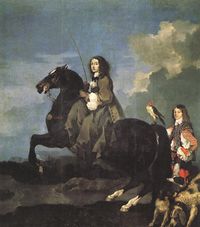
Queen Christina of Sweden, University Founder and Patron
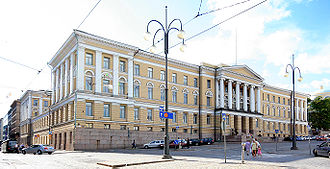
University of Helsinki (Main Building)
- For the early history (1640-1809), see the main article Royal Academy of Turku
The university was founded by Queen Christina of Sweden (1626–1689) in Turku, as the Royal Academy of Turku (拉丁语: Regia Academia Aboensis). It was the third university founded in the Swedish Empire, following Uppsala University and the Academia Gustaviana in Dorpat (predecessor to the University of Tartu in Estonia).
The second period of the University's history covers the period when Finland was a Grand Duchy of the Russian Empire, from 1809 to 1917. As Finland became part of the Russian Empire in 1809, Tsar Alexander I expanded the University and allocated substantial funds to it. Following the Great Fire of Turku in 1827, higher education within the country was moved to Helsinki, the new administrative heart of the Grand Duchy, in 1828, and renamed the Imperial Alexander University of Finland in honour of the late benefactor of the University. In the capital the primary task of the University was to educate the Grand Duchy’s civil servants.
The University became a community subscribing to the new Humboldtian ideals of science and culture, studying humanity and its living environment by means of scientific methods. The new statutes of the University enacted in 1828 defined the task of the University as promoting the development of “the Sciences and Humanities within Finland and, furthermore, educating the youth for the service of the Tsar and the Fatherland”.
The Alexander University was a centre of national life that promoted the birth of an independent Finnish State and the development of Finnish identity. The great men of 19th Century Finland, Johan Vilhelm Snellman, Johan Ludvig Runeberg, Elias Lönnrot and Zachris Topelius, were all involved in the activities of the University. The university became a major center of Finnish cultural, political, and legal life in 19th Century Finland, and became a remarkable primum mobile of the nationalist and liberal cultural movements, political parties, and student organisations.
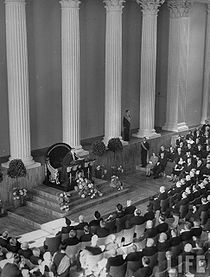
Main Auditorium, Helsinki University
In the 19th century university research changed from being collection-centred to being experimental, empirical, and analytical. The more scientific approach of the University led to specialisation and created new disciplines. As the scientific disciplines developed, Finland received ever more scholarly knowledge and highly educated people, some of whom entered rapidly evolving industry or the government.
The third period of the university's history began with the creation of the independent Republic of Finland in 1917, and with the renaming of the university as the University of Helsinki. Once Finland gained her independence in 1917 the University was given a crucial role in building the nation state and, after World War Two, the welfare society. Members of the academic community promoted the international relations of the new state and the development of its economic life. Furthermore, they were actively involved in national politics and the struggle for equality.
In the 20th century, scholarly research at the University of Helsinki reached the level of the European elite in many disciplines. This was manifested, among other things, by international recognitions granted to its professors, such as the Fields medal received by the mathematician Lars Ahlfors (1936), the Nobel Prize in Chemistry granted to Professor A.I. Virtanen (1945) and the Nobel Prize in Medicine shared by Professor Ragnar Granit (1967).
After World War II, university research focused on improving Finnish living conditions and supporting major changes in the structure of society and business. The University also contributed to the breakthrough of modern technology.
The progress of scientific development created many new disciplines and faculties at the University of Helsinki. At present the University comprises 11 faculties, 500 professors and almost 40,000 students. The University has established as its goal to be one of Europe’s top multidisciplinary research universities.
Campuses
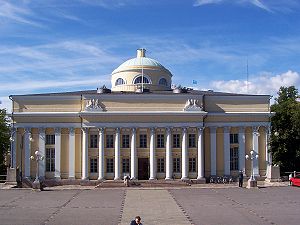
Helsinki University Library (Front)
The university is located on four main campuses. Originally, the entire university was located in the very centre of Helsinki, but due to the rapid growth of the university since the 1930s, premises have been built and acquired in other areas.
The historical City Centre Campus has been the hub of activity ever since the university moved from Turku to Helsinki in the early 19th Century. The campus has a central location and reflects the architectural style of this part of the city. The university buildings in the city center house the Faculties of Theology, Law, Arts, Behavioural Sciences and Social Sciences plus administrative functions. Most of the buildings on the campus have a major architectural significance ranging from the dominating Neo-Classical, through the Jugendstil, to 20th Century Modernism.
The Kumpula Campus, housing the Faculty of Science, is located four kilometers north from the centre of Helsinki near tram lines 6 and 8.
The Meilahti Campus, with the Faculty of Medicine, is a part of the Meilahti Hospital District on the edge of the city centre.
The Viikki Campus is located in the semi-suburban greenspace of the Viikki area, some 8 kilometres north-east of the city centre. It houses the Faculties of Agriculture and Forestry, Biosciences, Veterinary Medicine and Pharmacy.
Architecture
The Main Building (Päärakennus) of the university, which was designed by Carl Ludvig Engel, was completed in 1832. It is located next to the Senate Square in the heart of Helsinki's neoclassical centre, facing the Cathedral and the Government's Palace. Most of the important buildings in the City Centre Campus, such as the University Library (Kansalliskirjasto), the Observatory and several faculty buildings, are also designed by Engel.
The National Library of Finland
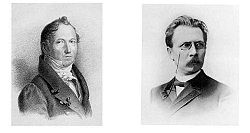
CL Engel and Gustaf Nyström, University Architects
The Library's main building is designed by architect C.L. Engel 1836 and was built in 1840-45. The annex is called the Rotunda and was built in 1902-06 by architect Gustaf Nyström.
The Fabiania building, named after its address at Fabianinkatu, was constructed in three phases. The middle part of the building was built for the University's Departments of Chemistry and Anatomy in 1844-46 by architect Jean Wiik. The wing facing Kirkkokatu was built in 1888-90 for the Department of Anatomy, and the wing facing Yliopistonkatu for the Department of Pharmacy in 1895-97. Both wings were designed by Gustaf Nyström. The Library moved into the building in 1998. In 1995-2001 the Fabiania and the Rotunda were renovated, and an underground passage connecting the two buildings was built. The project was designed by the architect's office Laiho-Pulkkinen-Raunio (architects Ola Laiho and Sinikka Selänne).
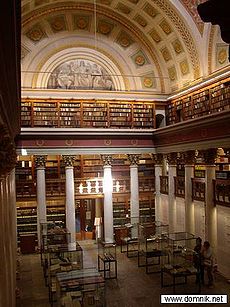
Main University Library (Interior)
The University Library's main building is one of the best known examples of the late 19th century Empire style in Finland and an important example of the European official library buildings of its time. Fire protection was the main idea when the building was planned: the building is not connected with the University Main Building, and the Library block was surrounded by leafy trees; the halls and rooms are all vaulted. In the design of the façade and the beautiful interiors, C. L. Engel in a personal way connected components of Classicism with allusions to the classical world. Of Engel's three alternative drawings for a library building, Czar Nicholas I selected the grandest one. The halls are symmetrically placed, and the ground plan can be traced to the Baths of Diocletian in Rome. The outer and inner architecture is based on a system of Corinthian columns. The façade echoes the architecture of a Classical temple: the pilasters and columns and the entablature above them are fitted exactly proportionally to the University Main Building.
The Library's large halls are all connected with one another. The main axis from the street leads straight into the heart of the Library, the Cupola Hall, and continues into the Rotunda. The Cupola Hall is connected with the two side halls that today are reading rooms, the South Hall and the North Hall. In the beginning there was no furniture in the halls, just the wall shelves behind the columns that support the galleries. The books were arranged by discipline. The columns are coated with stucco marble, and each hall has its own colour scheme. The painted ceiling ornaments are from 1881.
The three halls form a unique suite of rooms in Finnish architectural history, an academic temple devoted to research and science. This was emphasised by placing the entrance opposite the main entrance of the Cathedral. In this way the library building became a component in the total architectural setting of the Senate Square and its political message, to emphasise the political connection with Russia by architectural means.
In the 19th century there were works of art and plaster casts of ancient Greek and Roman statues in the halls. One of the lunettes in the North Hall was replaced in 1904 by a large oil painting, "The Golden Age", by Magnus Enckell. The North Hall was converted into a reading room in the 1890s.
The work on the Rotunda extension began in 1902, and the new part was taken into use in 1906-07. It has six floors above ground. The semicircular extension is surrounded by radially placed bookshelves accommodating approximately 200,000 volumes. Fire safety aspects were taken into consideration, and the building has a framework of steel and reinforced concrete. It was a very modern building, the first of its kind in Finland. The staircases are of reinforced concrete, the window frames and the construction that carries the glass roof are of iron, and the windows are of armoured glass. Architect Gustaf Nyström placed his Rotunda at the back side of Engel's old building in a very natural way; the fittings are, however, typically early 19th century style.
Externally the pillars of the Rotunda are adorned with reliefs personifying the sciences by the sculptor Walter Runeberg.
The building received its name, Fabiania, from its address at Fabianinkatu. It was built in three phases. The middle part was built for the Departments of Chemistry and Anatomy when it was found that there were certain problems related to their existence in the University Main Building. Architect Jean Wiik was the successor of C. L. Engel, and the laboratory building was his first independent work. It is in a simple symmetric classical style and is a plain, distinct office building compared to Engel's buildings for the University. The wings, designed by Gustaf Nyström, are more interesting with their details of cast iron and their more decorated façades.
The library yard was redesigned in 2001. The original iron fence and the trees are still on the Unionionkatu side. By the south wall there is a bronze bust of Czar Alexander I by Ivan Martos from 1814. It was originally ordered for the university in Turku, later it stood in the University's festivity hall and was placed in a library park in the 1950s. Near it is a memorial stone brought from Viipuri in 1988 that commemorates the book collector Matti Pohto.
组织
The university is divided into eleven faculties. They are listed below in the official order used by the university, reflecting both the history of the university and the hierarchy of disciplines at the time when the university was established:
- Faculty of Theology (established 1640)
- Faculty of Law (established 1640)
- Faculty of Medicine (established 1640)
- Faculty of Arts (Faculty of Philosophy established 1640 and split 1852, independent Arts section 1863, independent faculty 1992)
- Faculty of Science (Faculty of Philosophy established 1640 and split 1852, independent Science section 1863, independent faculty 1992)
- Faculty of Pharmacy (Faculty of Philosophy established 1640, split from the Faculty of Science 2004)
- Faculty of Biosciences (Faculty of Philosophy established 1640, split from the Faculty of Science2004)
- Faculty of Behavioral Sciences (independent section 1974, independent faculty 1992, reorganized and renamed 2004)
- Faculty of Social Sciences (established 1945)
- Faculty of Agriculture and Forestry (established 1898, independent faculty 1924)
- Faculty of Veterinary Medicine (established as an independent college in 1945, incorporated into the University of Helsinki in 1995)
The university also comprises several independent institutes, such as research centres and libraries, the most notable of which is perhaps the National Library of Finland.
Research institutes
Research institutes within the university include the following:
- Aleksanteri Institute – A national centre of research, study and expertise pertaining to Russia and East Europe
- Helsinki Center of Economic Research (HECER) – A joint initiative of the University of Helsinki, the Helsinki School of Economics and the Hanken School of Economics
- Helsinki Institute for Information Technology (HIIT) – A joint research institute of the University of Helsinki and the Aalto University
- Helsinki Institute of Physics
- Environmental Change Research Unit
- Institute of Biotechnology
- Neuroscience Center
- Rolf Nevanlinna Institute – Research institute of mathematics, computer science, and statistics
- Erik Castrén Institute of International Law and Human Rights
- Renvall Institute
- Christina Institute for Women's Studies
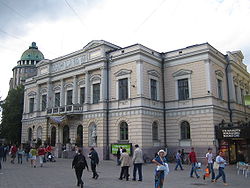
The Old Student House, Aleksanterinkatu.
Student Union
The Student Union of the University of Helsinki (Helsingin yliopiston ylioppilaskunta, HYY) was founded in 1868. It currently has 32,000 members and is one of the world's richest student organizations, with assets of several hundred million euros. Among other things, it owns a good deal of property in the city centre of Helsinki. The union has been at the centre of student politics from the 19th Century nationalist movements, through the actions of the New Left in the 1960s, up to the present. Its governing assembly consists of parties which are connected to faculty organisations, the Student Nations, and the mainstream political parties.
Notable People and Alumni
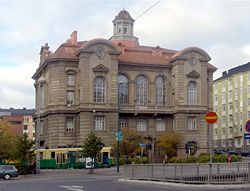
Natural History Museum, Helsinki University.
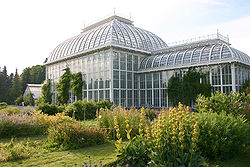
University of Helsinki Botanical Garden.
- Lars Ahlfors (1907–1996), mathematician, one of two first to be awarded the Fields Medal in 1936
- Anders Chydenius (1729–1803), priest, economist, politician
- Anders Donner (1854–1938), astronomer
- Elin Kallio (1859–1927), considered the founder of the women’s gymnastic movement in Finland.
- Ragnar Granit (1900–1991) Nobel Laureate (Medicine, 1967)
- Hugo Gyldén (1841–1896), astronomer
- Tarja Halonen, lawyer (LL.M.), the current President of Finland, since 2000.
- Pekka Himanen (b. 1973), philosopher.
- Jaakko Hintikka, philosopher and logician
- Bengt R. Holmström, economist
- Urho Kaleva Kekkonen, President of Finland
- Björn Kurtén (1924–1988), palaeontologist
- Werner Krieglstein, a University of Chicago fellow and Fulbright Scholar, philosopher, author, and actor
- Jarl Lindeberg (1876–1932), mathematician
- Ernst Lindelöf (1870–1946), mathematician
- Elias Lönnrot (1802–1884), collector of Kalevala
- Rolf Nevanlinna (1895–1980), mathematician
- Adolf Erik Nordenskiöld (1832–1901), geologist, Arctic explorer
- Gustaf Nordenskiöld (1868–1895), donor of the Mesa Verde artifacts to the National Museum of Finland
- Jorma Ollila (b. 1950), Chairman of Nokia and Royal Dutch Shell (M.Pol.Sci.)
- Juho Kusti Paasikivi, President of Finland
- Lauri Kristian Relander, President of Finland
- Risto Ryti, President of Finland
- Esa Saarinen (b. 1953), philosopher
- Jean Sibelius (1865–1957), composer, pursued studies at Faculty of Law
- Frans Emil Sillanpää (1888–1964), Nobel Laureate (Literature, 1939)
- Kaarlo Juho Ståhlberg, the first President of Finland
- Karl Fritiof Sundman (1873–1949), astronomer
- Pehr Evind Svinhufvud, President of Finland
- Zacharias Topelius (1818–1898), writer and historian
- Linus Torvalds, (b. 1969), software engineer and developer of Linux
- Artturi Ilmari Virtanen (1895–1973), Nobel Laureate (Chemistry, 1945)
- Jussi V. Koivisto, economist and educator (M.A.)
- Bror-Erik Wallenius (b. 1943), sports commentator
- Mika Waltari (1908–1979), novelist
- Georg Henrik von Wright (1916–2003), philosopher, the President of the Academy of Finland
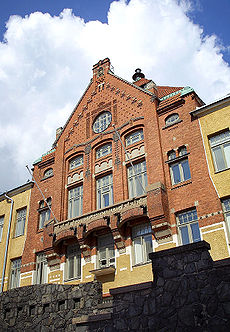
Faculty of Behavioral Sciences, Siltavuorenpenger 20
更多
- History of Finland
- Helsinki Senate Square
- List of universities in Finland
- Education in Finland
- Helsinki University of Technology
- Utrecht Network
- League of European Research Universities
- Europaeum
- UNICA
- Bologna Process
参考文献
- ^ Bologna Process at the University of Helsinki.[1]
- ^ Helsingin Sanomat, International Edition – Metro, 2.3.2006. "Assay finds research at University of Helsinki is of high international standard".[2]
- ^ UNICA = "Institutional Network of the Universities from the Capitals of Europe".
- ^ University of Helsinki – "Top Research" Publication.[3]
- ^ Helsinki University – International Affairs Office.[4]
- ^ Helsinki University, Building The Future Since 1640.[5]
- ^ The National Library of Finland, Homepage. [6]
- ^ [7]
External links
 |
Wikimedia Commons has media related to: University of Helsinki |
- University of Helsinki – Official site
- Presentation of premises – Images of almost all university buildings and their lecture rooms
- Helsinki.fi city portal – maintained by University of Helsinki and City of Helsinki

Senate Square (University Main Building, Left)



